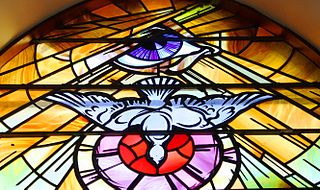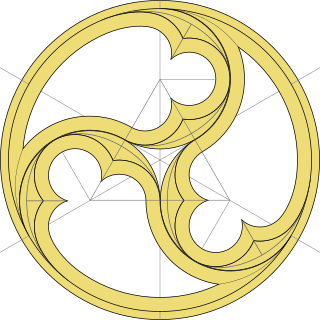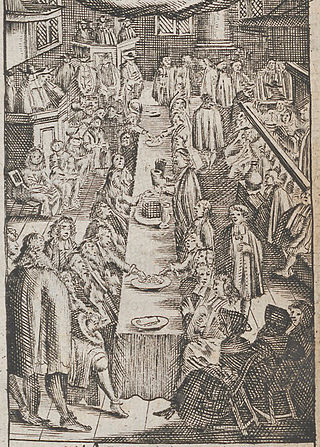
Anglo-Catholicism comprises beliefs and practices that emphasise the catholic heritage and identity of the various Anglican churches.

Mary Flannery O'Connor was an American novelist, short story writer and essayist. She wrote two novels and 31 short stories, as well as a number of reviews and commentaries.

In Western Christian theology, grace is created by God who gives it as help to one because God desires one to have it, not necessarily because of anything one has done to earn it. It is understood by Western Christians to be a spontaneous gift from God to people – "generous, free and totally unexpected and undeserved" – that takes the form of divine favor, love, clemency, and a share in the divine life of God. In the Eastern Orthodox Church, grace is the uncreated Energies of God. Among Eastern Christians generally, grace is considered to be the partaking of the Divine Nature described in 2 Peter 1:4 and grace is the working of God himself, not a created substance of any kind that can be treated like a commodity.
Andrew M. Greeley was an American Catholic priest, sociologist, journalist and popular novelist.

The real presence of Christ in the Eucharist is the Christian doctrine that Jesus Christ is present in the Eucharist, not merely symbolically or metaphorically, but in a true, real and substantial way.

In Christian theology, the term Body of Christ has two main but separate meanings: it may refer to Jesus Christ's words over the bread at the celebration of the Jewish feast of Passover that "This is my body" in Luke 22:19–20, or it may refer to all individuals who are "in Christ" 1 Corinthians 12:12–14.
Karl Adam was a German Catholic theologian, known for his work in the fields of ecclesiology and Christology. He spent most of his academic career at the University of Tübingen, where he published work influenced by Lebensphilosophie and German Romanticism including The Spirit of Catholicism (1924), which argued for an understanding of the church as a community and for a revitalisation of Christian faith. Following Adolf Hitler's rise to power in 1933, Adam sought a rapprochement between the Nazi regime and the German Catholic Church. In pursuit of this aim, he published work during the Nazi era that sought to reconcile aspects of Catholic and nationalist thought, defended Nazi anti-Jewish legislation and expressed anti-Semitic sentiments. His later work included The Christ of Faith (1954), a collection of lectures on Christology.

Blood of Christ, also known as the Most Precious Blood, in Christian theology refers to the physical blood actually shed by Jesus Christ primarily on the Cross, and the salvation which Christianity teaches was accomplished thereby, or the sacramental blood (wine) present in the Eucharist or Lord's Supper, which some Christian denominations believe to be the same blood of Christ shed on the Cross.

Perichoresis is a term referring to the relationship of the three persons of the triune God to one another. Circumincession is a Latin-derived term for the same concept. It was first used as a term in Christian theology, by the Church Fathers. The noun first appears in the writings of Maximus Confessor but the related verb perichoreo is found earlier in Gregory of Nazianzus. Gregory used it to describe the relationship between the divine and human natures of Christ as did John of Damascus, who also extended it to the "interpenetration" of the three persons of the Trinity, and it became a technical term for the latter. It has been given recent currency by such contemporary writers as Jürgen Moltmann, Miroslav Volf, John Zizioulas, Richard Rohr, and others.
Branch theory is an ecclesiological proposition that the One, Holy, Catholic, and Apostolic Church includes various different Christian denominations whether in formal communion or not. The theory is often incorporated in the Protestant notion of an invisible Christian Church structure binding them together.
Theological aesthetics is the interdisciplinary study of theology and aesthetics, and has been defined as being "concerned with questions about God and issues in theology in the light of and perceived through sense knowledge, through beauty, and the arts". This field of study is broad and includes not only a theology of beauty, but also the dialogue between theology and the arts, such as dance, drama, film, literature, music, poetry, and the visual arts.

The Protestant Reformation during the 16th century in Europe almost entirely rejected the existing tradition of Catholic art, and very often destroyed as much of it as it could reach. A new artistic tradition developed, producing far smaller quantities of art that followed Protestant agendas and diverged drastically from the southern European tradition and the humanist art produced during the High Renaissance. The Lutheran churches, as they developed, accepted a limited role for larger works of art in churches, and also encouraged prints and book illustrations. Calvinists remained steadfastly opposed to art in churches, and suspicious of small printed images of religious subjects, though generally fully accepting secular images in their homes.

"Revelation" is a Southern Gothic short story by author Flannery O'Connor about the delivery and effect of a revelation to a sinfully proud, self-righteous, middle-aged, middle class, rural, white Southern woman that her confidence in her own Christian salvation is an error. The protagonist receives divine grace by accepting God's judgment that she is unfit for salvation, by learning that the prospect for her eventual redemption improves after she receives a vision of Particular Judgment, where she observes the souls of people she detests are the first to ascend to Heaven and those of people like herself who "always had a little of everything and the God-given wit to use it right" are last to ascend and experience purgation by fire on the way up.
David W. Tracy is an American theologian and Roman Catholic priest. He is Andrew Thomas Greeley and Grace McNichols Greeley Distinguished Service Professor Emeritus of Catholic Studies at the University of Chicago Divinity School. In 2020 he was elected to the American Philosophical Society.
American Catholic literature emerged in the early 1900s as its own genre. Catholic literature is not exclusively literature written by Catholic authors or about Catholic things, but rather Catholic literature is "defined [...] by a particular Catholic perspective applied to its subject matter."

A sacrament is a Christian rite that is recognized as being particularly important and significant. There are various views on the existence, number and meaning of such rites. Many Christians consider the sacraments to be a visible symbol of the reality of God, as well as a channel for God's grace. Many denominations, including the Roman Catholic, Lutheran, Presbyterian Anglican, Methodist, and Reformed, hold to the definition of sacrament formulated by Augustine of Hippo: an outward sign of an inward grace, that has been instituted by Jesus Christ. Sacraments signify God's grace in a way that is outwardly observable to the participant.

David William Brown is an Anglican priest and British scholar of philosophy, theology, religion, and the arts. He taught at the universities of Oxford, Durham, and St. Andrews before retiring in 2015. He is well-known for his "non-punitive theory of purgatory, his defense of specific versions of social Trinitarianism and kenotic Christology, his distinctive theory of divine revelation as mediated fallibly through both tradition and imagination, and his proposals regarding a pervasive sacramentality discerned in nature and human culture alike."

In Reformed theology, baptism is a sacrament signifying the baptized person's union with Christ, or becoming part of Christ and being treated as if they had done everything Christ had. Sacraments, along with preaching of God's word, are means of grace through which God offers Christ to his elect. Sacraments are believed to have their effect through the Holy Spirit, but these effects are only believed to accrue to those who have been predestined to have faith in Christ.

Criticism of Protestantism covers critiques and questions raised about Protestantism, the Christian denominations which arose out of the Protestant Reformation. While critics may praise some aspects of Protestantism which are not unique to the various forms of Protestantism, Protestantism is faced with criticism mainly from the Catholic Church and the Eastern Orthodox Church, although Protestant denominations have also engaged in self-critique and criticized one another. According to both the Catholic Church and Eastern Orthodoxy, many major, foundational Protestant doctrines have been officially declared heretical.

In Reformed theology, the Lord's Supper or Eucharist is a sacrament that spiritually nourishes Christians and strengthens their union with Christ. The outward or physical action of the sacrament is eating bread and drinking wine. Reformed confessions, which are official statements of the beliefs of Reformed churches, teach that Christ's body and blood are really present in the sacrament, and that believers receive, in the words of the Belgic Confession, "the proper and natural body and the proper blood of Christ." The primary difference between the Reformed doctrine and that of Catholic and Lutheran Christians is that for the Reformed, this presence is believed to be communicated in a spiritual manner rather than by his body being physically eaten. The Reformed doctrine of real presence is called "pneumatic presence".















